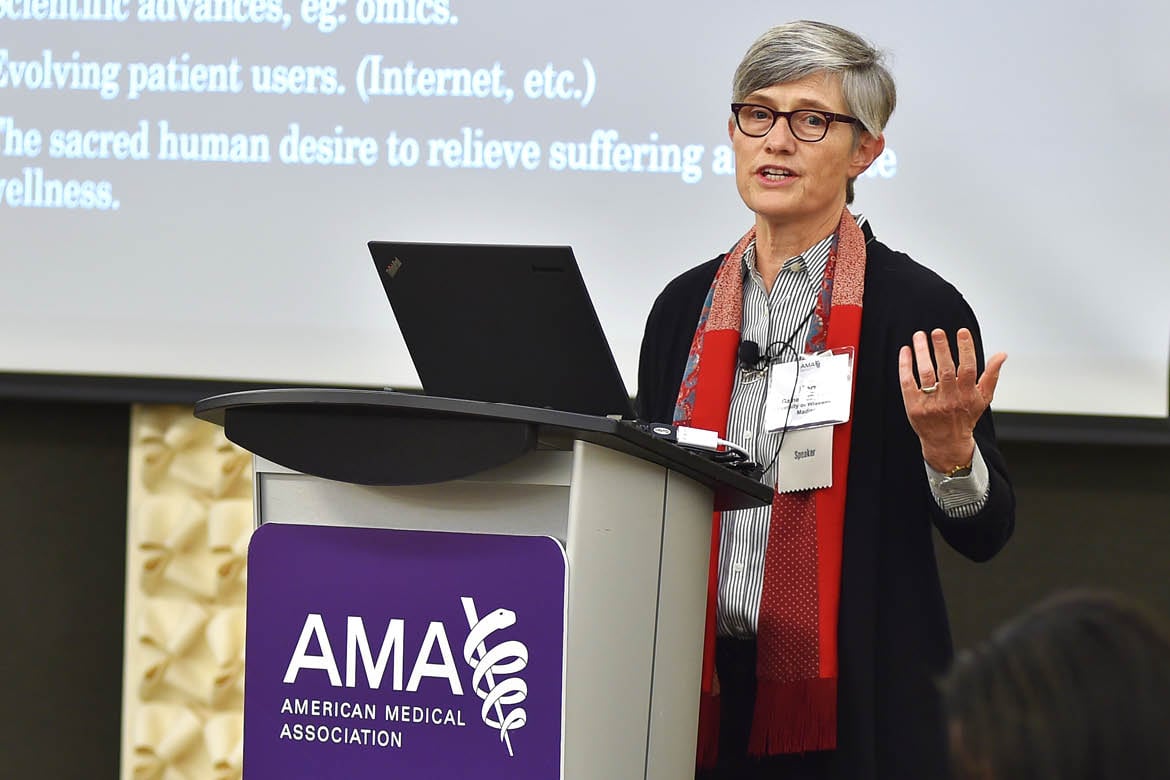Which skills and qualities should typify the physician of the future? Answering this question is crucial for medical schools, especially given the many forces acting on medical education, including health care funding, the impact of technology and evolving patient users. According to one expert, the answer is clear but also complex: The physician of the future will need to be a little bit of everything.
Meg Gaines, JD, LLM, is a distinguished clinical professor of law at the University of Wisconsin–Madison. She is also a co-founder of The Center for Patient Partnerships, which trains students from the schools of Law, Medicine, Nursing, Pharmacy and Social Work to provide advocacy to cancer patients and conducts research on issues relevant to patient care and health care delivery from the patient perspective.
At a recent meeting of the AMA’s Accelerating Change in Medical Education Consortium in Chicago, she described the physician of the future from her perspective as an interprofessional team member.
“Patients will need their doctors to be advocates,” Gaines said.
And partnering, she explained, will be the key to fulfilling that role.
“[It’s] the vital 21st century skill,” she said. “For practicing professionals, I think we need to be even more Leonardo da Vinci than we have been before, crossing the professional boundaries, being a little bit lawyers, a little bit doctors, a little bit nurses, a little bit social workers.”
Collaboration is already required at all levels, she noted, foremost with patients, but it will gain its fullest expression out in the community in the pursuit of the social determinants of health. It is the mechanism that will enable physicians to go upstream of not only many patients’ health problems but also some of physicians’ own health problems, such as burnout.
Overcoming barriers to change
Getting there, Gaines thinks, will require change not just in medical education but also in what physicians consider their scope of work.
“[One] of the barriers is the guild mentality in all professions, including medicine,” she said. We have ego stuff—it’s true in law too. We own some things, and we don’t like it when the Internet allows you to [do them] without us. So we really do have to be ready to let go of some things.”
One of the things Gaines says physicians will have to let go of is what she calls “the rescue fantasy.”
“[It’s] this notion that we’re putting all this time and energy into this gestalt that’s about saving people’s lives, when really we do relatively little of that—maybe if we’re trauma surgeons [we do] more of it—but mostly what we do is empower people to save their own lives. And that’s what we have to teach.”
That means building curricula for how to build capacity in others, she explained.
“Do the math,” she said. “There aren’t ever going to be enough of you to take care of all of us. So you have to have us taking care of ourselves. I want every primary care doctor to have a sign up in their office that says, ‘You are your own primary care provider 99.9 percent of the time. How can I help you?’”
Gaines noted her own involvement as a primary investigator for healthesxperiencesusa.org, the US arm of the University of Oxford’s healthtalk.org, which recently published its first module, on young adults’ experiences with depression. The module is not a collection of anecdotes; it is a qualitatively and quantitatively researched sampling of experiences that people from across the US have had. It’s an example, Gaines noted, of using technology to teach and not having to have people in the room with a patient.
On the edge of a new education frontier
Another core element of a new curriculum, Gaines said, will be self-care and well-being, and this will require medical schools to embrace human fallibility.
“[Professional curricula is] big on teaching striving for excellence and [not] on teaching what happens when you say, ‘Uh oh, wish I’d done that differently.’” Gaines said. “I think it comes from being afraid that if we let down our façade of striving for excellence, [our students] will be ordinary, and we just have to let go of that. We need to help them figure out what happens at the ‘Uh oh’ moment and how they can stay alive and even well and get past it and help each other.”
Gaines thinks such a shift will have some discomforting implications for medical schools, but the discomfort will be temporary because physicians embrace change.
“[Students] do what they see us do, not what we tell them,” she said. “So we need to co-create curriculum with patients, families and communities. We have to walk our talk. There’s no way around it. And our first reaction—trust me, I have it—is, ‘Yikes! How do we do that?!’ This is a new frontier.”




